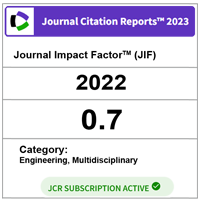MODEL PENERIMAAN TEKNOLOGI LANJUTAN BAGI MERAMAL KEINGINAN MENGGUNAKAN SISTEM PERINGATAN TOPI KELEDAR
DOI:
https://doi.org/10.11113/jt.v77.4143Keywords:
Motorcyclist, safety helmet, technology acceptance model, regressionAbstract
Motorcycle is a common transport use in Malaysia compared to other transportation such as car. However, every year motorcyclist is the highest contributors towards road death accident statistic. This paper presents a new intervention to enhance the safety of motorcyclist regarding head injuries issue. A new approach called conceptual design of Safety Helmet Reminder (SHR) system is proposed. The Technology Acceptance Model (TAM) is adopted to predict behavioral intention to use SHR among motorcyclists. The self- administered questionnaires were distributed among 300 motorcyclists as respondent in Batu Pahat, Johor. The data were analyzed using a correlation and hierarchical multiple regression analysis. The results show that all variables are highly correlated, positive linear relationship and significantly at 0.01 (p<0.01). In addition, the hierarchical multiple regression demonstrates perceived ease of use, behavioral intention to use SHR and additional variables (perceived safety, subjective norm and descriptive norm) are found significant (p<0.05). As a conclusion, perceived safety, subjective norm, descriptive norm, perceived ease of use and behavioral intention to use technology remained a significant predictor of helmet use. However, perceived usefulness and attitude toward using technology were not significant in predicting helmet use among motorcyclist.
References
I. S. Abdul Kadir, R. S. Radin Umar, H. H. K. Midi, M.Stevenson, and A. Hariza. 2006. Mode choice model for vulnerable Motorcyclists in Malaysia. Traffic Injury Prevention. 7: 1-5.
K. Ambak, R. Ismail, R. A. Abdullah, M. N. Borhan. 2011. Using Structural Equation Modelling and the Behavioral Sciences Theories in Predicting Helmet Use in the Proceeding of the International Conference on Andvances Sciences, Engineering and Information Technology 2011. Putrajaya, 639-645.
K. Ambak, A. Riza and I. Rozmi. 2009. Intelligent Transports System for Motorcycle Safety and Issues. Eur. J. Sci. Res. 28(4): 600-611.
Fernandez, F. A. O., Alves De Sousa, R. J. 2013. Motorcycle Helmets- A State of the Art Review. Accident Analysis and Prevention. 56: 1-21.
R. S. Radin Umar, S. Kulanthayan, T. H. Law, H. Ahmad, A. H. Musa, and N. M. T. Mohd. 2000. Helmet Initiative Programs in Malaysia. Pertanika J. Sci & Technol. Supplement. 13(1): 29-40.
A. M. Manan, and M. Varhelyi. 2012. Motorcycle fatalities in Malaysia. IATSS. 36: 30-39.
M. B. Ahmed, K. Ambak, A. Raqib, and N. S. Sukor. 2013. Helmet Usage Among Adolescent in Rural Road from the Extended Theory of Planned Behavior. Journal of Applied Sciences. 13(1): 161-166.
Jabatan Keselamatan Jalan Raya (JKJR). 2006. Malaysian Road Safety Plan 2006-2010. Ministry of Transport Malaysia.
G. L. Li, L.P. Li, and Q. E. Cai. 2008. Motorcycle helmet use in Sothern China: An Observational study. Traffic Inj. Prev. 9: 125-128.
Polis Diraja Malaysia (PDRM). 2012 Statistical Report on Road Accidents in Malaysia. Traffic Branch, Bukit Aman, Kuala Lumpur.
F. D. Davis. 1989. Perceived Usefulness, Perceived Ease of Use, and User Acceptance of Information Technology. MIS Quarterly. 13: 319-340.
Kulanthayan, S., R. S. Umar, H. A. Hariza, M. T. Nasir Harwant. 2000. Modelling of Compliance of Motorcyclist to Proper Usage of Safety Helmet In Malaysia. J. crash Prev. Inj. Control. 2: 239-246.
K. Ambak, H. Hashim, I. Yusoff, and David, B. 2010. An Evaluation on the Compliance to Safety Helmet Usage Among Motorcyclists in Batu Pahat, Johor. International Journal of Integrated Engineering. 2(2): 1-8.
Choi, Y. Kyun., and Jeff, W., Totten. 2012. Self-construal’s Role in Mobile TV Acceptance: Extension of TAM Across Cultures. Journal of Business Research. 65(11): 1525-1533.
W. Ceccucci, P. Alan, and S. Patricia. 2010. An Empirical Study of Behavioral Factors Influencing Text Messaging Intention Text Messaging. Journal of Information Technology Management. (1): 16-34.
A. Wibowo. 2008. Research on Consumer Behavior Information Systems Approach to Technology Acceptance Model (TAM). Universitas Budi Luhur Jl.
Venkatesh, Moris, M. G., Davis, G. B., and Davis, F. D. 2003, User Acceptance of Information Technology: Toward a Unified View. MIS Querterly. 27(3): September, 425-475.
Osswald, S., Wurhofer, D., Trösterer, S., Beck, E., & Tscheligi, M. 2012. Predicting Information Technology Usage in the Car : Towards a Car Technology Acceptance Model. In Precedings of the 4th International Conference on Automotive User Interfaces and Interactive Vehicular Applications. 51-58.
Y. P. Chua. 2014. Asas Statistik Penyelidikan. Edisi ke-3. Kuala Lumpur, Mc Graw Hill Education.
J. E. Bartlett, J. W. Kotril, and C. C. Higgins. 2011. Organizational Research: Determining Appropriate Sample Size in Survey Research. Information Tech., Learning and Performance Journal. 19(1): 43-50.
R. Weston, and P. A. Gore. 2006. A Brief Guide to Structural Equation Modeling. Couns Psychol. 34(5): 719-751.
D. C. Chun, W. F. Yi, and K. F. Cheng. 2007. Predicting Electronic Toll Collection Service Adoption: An Integration of the Technology Acceptance Model and the Theory of Planned Behavior. Transportation Research Part C. 15: 300-311.
K. Ambak, R. Ismail, R. A, Abdullah, A. A. Latif, and M. E. Sanik. 2013. Application of Technology Acceptance Model in Predicting Behavioral Intention to Use Safety Helmet Reminder System. Research Journal of Applied Science, Engineering and Technology. 5(3): 881-888.
Y. P. Chua. 2012. Ujian Regresi, Analisis Faktor dan Analisis SEM. Edisi ke-5, Kuala Lumpur, Mc Graw Hill Education.
Downloads
Published
Issue
Section
License
Copyright of articles that appear in Jurnal Teknologi belongs exclusively to Penerbit Universiti Teknologi Malaysia (Penerbit UTM Press). This copyright covers the rights to reproduce the article, including reprints, electronic reproductions, or any other reproductions of similar nature.





